Report from Autosport of 20th October 1977
Finnish Grand Prix
Finns dominate a superb event although Russell Brookes fights back to second place - Hannu Mikkola's Toyota Corolla robbed of victory by a puncture - Impressive performance from Fiat augers well for RAC - Vauxhall move even closer to a national series victory - Nigel Rockey and Graham Elsmore both win their respective championships .
Report: PETER NEWTON - Photography: HUGH BISHOP
Three of the world's fastest and most experienced loose surface rally drivers competed against each other on a blissful October day in central Wales last weekend. They competed over some 92 miles of forestry roads, the finest in the land, and together with a solitary Englishman they dominated the day to a predictably crushing degree.
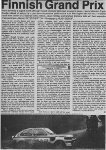
Besides Russell Brookes, only Andy Dawson and John Taylor were able to break into the top five fastest times (twice and once respectively) and while rally speeds continue to escalate alarmingly with the passing months, it is the Finns who are still able to set the standard. They have almost accepted Russell Brookes now. Grudgingly, they concede that he may on the odd occasion beat their best, but they refuse to accept the validity of the efforts of others. Sadly, last weekend gave them no further cause to reconsider their assessment of the current situation, and the only Englishman who might have been able to join Brookes was not even present-Tony Pond. . . as a pointer to RAC Rally form, it appears that once again the Finns have every chance of disputing the great event among themselves. In general, the equipment is now available to beat them, so what else is required? A tougher mental attitude? Luckily there is no welfare state in British rallying!
The Castrol '77, thanks to its magnificent long stages, can so easily be decided by punctures. Last year, tyres played a vital role in proceedings and once again they did so this year, as after a superb drive in Team Toyota Europe's diminutive Corolla 2-litre, Hannu Mikkola lost the rally during the afternoon while holding an 18-second lead. Hannu had led from the outset but it was far more than one dared to hope that after another season of wretched luck he would at last win another rally. It seemed as though he too was half-expecting some malady to thwart him, but this time he led almost to the finish itself before the instant deflation of a front tyre, just two miles into Hafren 2, sealed his fate. Thus a delighted Airikkala took another relaxed and confident win for DTV which further enhances their now excellent chances of national championship victory this year. There was little doubt that he could have driven faster had he really wanted to win, but his eyes are now firmly focused on the championship, and there was going to be no repeat of the momentary lapse on the Lindisfarne which could so easily have thrown away the efforts of a year's hard unrelenting work with the Chevette. Fully recovered from the minor illness which in Kielder helped to cloud his normally highly perceptive, analytical judgment Pentti avoided banks, ditches and boulders, keeping the car as straight as possible while giving no outward sign of ever trying as hard as he is capable. Airikkala has now made himself all but indispensible to DTV's continued ascendance and the team's chances of winning the championship in the Chevette's first ever season of rallying now seem to be very high - it's an impressive achievement.

"Airikkala went out to collect a good placing but was presented with a win through Mikkola's misfortune. Pentti drove faultlessly all day."
Russell Brookes is left with possibilities, but no one would ever imply that they are encouraging. To win the series he must finish third British licence holder on the Lombard RAC (or better) and beat Pentti Airikkala. Since British licence holders now include Markku Alen alongside Mikkola and Airikkala, Russell Brookes may have to win the RAC-but then this is an ambition which he keenly wants to fulfil! Afflicted by the aftermath of 'flu, Russell's hesitant start to the morning's stages (just two of them equalling over 30 miles) cost him the rally. He spun or half-spun no less than five times during the course of these two tests-a combination of maladjusted brake bias and a 'hangover' from his virus ailment contributing in no small measure; but the 23 seconds which he lost to Airikkala in these two tests were more than enough to keep him in second place at the finish despite an excellent late day challenge which demoted Alen to third place on the final stage of the day. He left it just too late. . . .
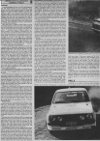
Alen however drove with all his usual style and determination. He is rather more open with his emotional involvement in the sport than most of his countrymen, though they are obviously no less committed. Typical of his driving was the result of an incident in Hafren when despite a rear wheel puncture three and a half miles from the finish of the afternoon's test, he still posted a time only one second slower than Russell. The spectating was indeed a sight to behold! This encouraging result for Fiat must have disturbed the papers on the desks at Boreham airfield, for the OlioFiat entry for Markku was by no means a sparkling crisp new motorcar, but an ex-Simo Lampinen 1000 Lakes and Quebec veteran - a machine fitted with none of the latest 'go faster' Italian equipment like a dry sump kit or redesigned fuel injection throttle slides etc. Fitted with an obviously very tired power unit, and scarcely touched since its outing in Canada (although having been returned to Turin) Markku proved the Fiat highly competitive on the smooth, fast stages of Hafren, Dovey and Myherin. Perhaps the 131s will not be so quick in other (rougher) parts of the country, but Ford will obviously have a major task on their hands to keep Alen out of the first four RAC places-his stage times were a model of consistency and the car ran with clockwork reliability.
Final word should be reserved for the Castrol/Autosport championship, and the organising club themselves. Until the two final stages of the day, when Faulkner's clutch trouble deteriorated rapidly, Nigel Rockey and Paul had been engaged in a private battle that has been very much a feature of this year's championship. The series irrevocably belongs to Nigel now, and it is with some sense of relief that both crews can prepare for the RAC without having to resort to the Wyedean Stages in the interim to resolve their differences. Paul has had to settle for second in the championship (for the second time in four years) and the Simpson brothers will have to work hard in the Dean if they are to regain their third place (and ensure a Goodyear 1-2-3) in the series.
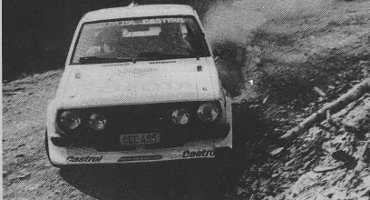
"Mikkola in his element on Pantperthog. A masterly drive was once again cut short - this time by a puncture."
It would probably be true to say that Wolverhampton and South Staffs CC have achieved a large portion of their aims with the Castro] '77. Their rally (along with the Cheltenham Festival and the Jim Clark to a greater or lesser extent) is the definitive national event in this country. Once more it was organised with level-headed decisiveness by principal officials, and this year was promoted (as well as supported) with energy and enthusiasm by Castrol. The results were mass satisfaction and mutual enjoyment. The club's members enjoy both rallying and socialising; the combination ensures a most hospitable and convivial weekend.
This rally leaves a memory which lingers into the deepening months of winter; the soda syphon fight of last year (although this writer hastens to add that he was not present!) proved even bigger and better than before . . . perhaps because it had an added variation-buckets! And someone somewhere has not only been able to control the whims of the weather in three successive years, but with typical panache the prize giving on the pier at Aberystwyth was even arranged to coincide with high tide. Archimedes certainly knew one or two things about suspended animation and it is typical that the club should salute his principles with such forethought! (Despite a vast influx of guests on Saturday night, the ageing and rather decrepid pier is still standing firm . . . perhaps the support of the sea really did help!)
It is one thing when a young Finn with a name like Vatanen and a competition experience of scarcely 200kms is deposited in the midst of the best on a rally like the Castrol '77; quite another when he is caught red-handed driving up one of the stages on the afternoon prior to the start! As pre-rally gossip, such stories don't come much better than this one, so it wasn't at all surprising that its proportions were `adjusted' and distorted almost immediately. The incident itself was given added notoriety by the fact that the Vatanen heritage still remains a sensitive area as far as most British competitors are concerned. That residual feeling added to the fact that a drive in one of David Sutton's excellent RS1800s (yes, even a very tired one) is a prize to which even very few !Finns (let alone Englishmen!) are entitled, gave the story an added poignancy.
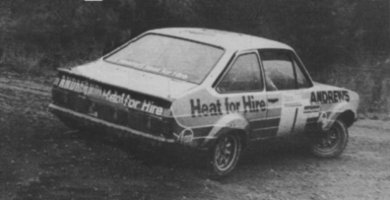
"Russel Brookes, suffering the aftermath of flu in the morning and a wrong tyre choice in the afternoon put any dispute with the winner out of the question."
The reality amid all the chatter of 'practising' etc was considerably less sensational and seems to have involved a very ill-judged decision by a member of the team.
Tatu, who arrived in England on Thursday clutching a pair of sheets in addition to his other personal belongings (whatever do they think we sleep on over here?!) had never driven the car before, so he was naturally instructed to drive it to Wales and get the feel of an RS1800. Once there, it was decided that should the team happen upon a suitable piece of straight loose surface, then Tatu should set-up the brakes as he wished them to be.
Thanks to a classic error of Keystone proportions (which in other circumstances might even have been amusing) they drove into the start of Myherin and after just 400 yards were seen by the stage commander and four witnesses who were busily setting up the test for the morrow! Any allegations of practising are, however, as ridiculous as they are naive. Even if the team had wanted to attempt such an unwise move, one can rest assured that David Sutton, one of the most experienced men in the business, would not have gone about the procedure in such a clumsy, amateur fashion.
Neither Sutton nor co-driver Peter Bryant were present at the time, and Tatu did not even have a map with him. Nevertheless David Stephenson would undoubtedly have barred him from taking part on Saturday if he could have done so (there was emphatically no sentiment involved whatsoever) but the incident also revealed a loophole in the regulations! Thus Tatu's indiscretion was reported to the Stewards of the rally who fined the team a total of £180 (the maximum possible) for conduct prejudicial to the sport.
Just after the ford in Myherin (SS1) on a tightening left hand bend, the young Vatanen ended a sad and depressing episode by putting the car off into the trees where it was later seriously damaged by Pat Batten's Imp, which flew off at the same place and landed on top of the stricken Escort. This was the first occasion on which David Sutton had taken out comprehensive insurance cover for the car!
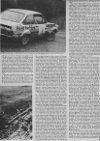
A combination of the smooth, tightly-packed shale surfaces to be found in the central Wales forest belt, and an excess of rain produces a surface which is deceptively treacherous. For the most part, the roads look (and are) very quick but the lack of adhesion available is only too easily overlooked until
At 22½ miles, the afternoon test in Hafren was to be the longest of the day. This stage was nearly relegated to second best however. It cannot have escaped many people's notice that the two Dovey tests are joined by a short stretch of tarmac public road. It is this small section of road in which Clerk of the Course David Stephenson has been so interested for so many months. Finally, and only last week after great and energetic efforts, he secured a temporary road closing order! Not since the days of the Gulf London's would Dovey have been run in such a manner. Alas, insurance was not forthcoming and proved to be the unlikely stumbling block which thwarted efforts at the 11th hour.
Nevertheless the mixture remained exactly what competitors wanted and thanks to the addition of an arrival control before stage starts, the event ran smoothly and to schedule (a feat which is of course much easier to ensure with so few stages and only one service area). There was very little to fault save one or two erroneous entries on time cards at Hafren which were later rapidly corrected from the check sheets. The rains, and more importantly, Forestry Commission work, had made both the start and finish of this test extremely muddy. Thus, on Saturday the stage was started 5.5 miles farther into the forest in the afternoon owing to the condition of the road. There was a similarly muddy section about one mile after the spectator areas in Dovey, but the club issued sufficient warnings and there seemed to be few who either fell foul of it or had any excuses for doing so.
It's difficult to know where the Castrol 77 goes from here. That much became all too obvious last weekend as one pressed through the throng carousing in the cramped pierhead premises above Cardigan Bay. A move to the University could not occur in term time, and besides, the return to the hotels from the former's premises would probably jeopardise the rally's relations with the town.
Meanwhile, an entry filled to capacity (there were just eight non-starters in a massive 180-strong field) merely underlined the futility of our now defunct system whereby `paper' internationals mingle with lesser status events in the same championship. the quality of the Castrol '77's leading runners would have put any `international' entry this year to shame, so powerful and varied were its contents; only Leyland were absent. To be sure a number of the 'stars' were competing on account of the proximity of the Lombard RAC for which this rally is ideal both in terms of content and calendar, but this does not entirely explain the vast hordes of clubmen who flock to Aberystwyth, drawn by the challenge it presents and the qualitythe point of no return. There are subtle surface changes which are hard to identify for an untrained eye, but it is the length of the stages which as much as anything sorts out the experts from the novices, also-rans, hopefuls and hopeless. For the experience in such matters, 23 minutes-worth of intense concentration at high speed in a forest is something to be taken in one's stride; but its another matter for those of us accustomed to three minute bogey times and slow stages. The forest roads in Dovey, Myherin, Pantperthog and Hafren 'flow' in sequences of fast bends, occasionally tightening, losing and gaining altitude but seldom necessitating speeds to drop below 40/50mph. there is a marked absence of long straights and square corners so prevalent in other parts of the country. these are real driver's stages which put skill and judgment at a premium. These are some of the reasons for the magnitude and number of both entry and accidents.
At 22½ miles, the afternoon test in Hafren was to be the longest of the day. This stage was nearly relegated to second best however. It cannot have escaped many people's notice that the two Dovey tests are joined by a short stretch of tarmac public road. It is this small section of road in which Clerk of the Course David Stephenson has been so interested for so many months. Finally, and only last week after great and energetic efforts, he secured a temporary road closing order! Not since the days of the Gulf London's would Dovey have been run in such a manner. Alas, insurance was not forthcoming and proved to be the unlikely stumbling block which thwarted efforts at the 11th hour.
Nevertheless the mixture remained exactly what competitors wanted and thanks to the addition of an arrival control before stage starts, the event ran smoothly and to schedule (a feat which is of course much easier to ensure with so few stages and only one service area). There was very little to fault save one or two erroneous entries on time cards at Hafren which were later rapidly corrected from the check sheets. The rains, and more importantly, Forestry Commission work, had made both the start and finish of this test extremely muddy. Thus, on Saturday the stage was started 5.5 miles farther into the forest in the afternoon owing to the condition of the road. There was a similarly muddy section about one mile after the spectator areas in Dovey, but the club issued sufficient warnings and there seemed to be few who either fell foul of it or had any excuses for doing so.
It's difficult to know where the Castrol 77 goes from here. That much became all too obvious last weekend as one pressed through the throng carousing in the cramped pierhead premises above Cardigan Bay. A move to the University could not occur in term time, and besides, the return to the hotels from the former's premises would probably jeopardise the rally's relations with the town.
Meanwhile, an entry filled to capacity (there were just eight non-starters in a massive 180-strong field) merely underlined the futility of our now defunct system whereby `paper' internationals mingle with lesser status events in the same championship. the quality of the Castrol '77's leading runners would have put any `international' entry this year to shame, so powerful and varied were its contents; only Leyland were absent. To be sure a number of the 'stars' were competing on account of the proximity of the Lombard RAC for which this rally is ideal both in terms of content and calendar, but this does not entirely explain the vast hordes of clubmen who flock to Aberystwyth, drawn by the challenge it presents and the qualityult to know where the Castrol 77 goes from here. That much became all too obvious last weekend as one pressed through the throng carousing in the cramped pierhead premises above Cardigan Bay. A move to the University could not occur in term time, and besides, the return to the hotels from the former's premises would probably jeopardise the rally's relations with the town.
Meanwhile, an entry filled to capacity (there were just eight non-starters in a massive 180-strong field) merely underlined the futility of our now defunct system whereby `paper' internationals mingle with lesser status events in the same championship. the quality of the Castrol '77's leading runners would have put any `international' entry this year to shame, so powerful and varied were its contents; only Leyland were absent. To be sure a number of the 'stars' were competing on account of the proximity of the Lombard RAC for which this rally is ideal both in terms of content and calendar, but this does not entirely explain the vast hordes of clubmen who flock to Aberystwyth, drawn by the challenge it presents and the quality of the roads. It's possible to learn real techniques on roads such as these; techniques which would be all but impossible to investigate elsewhere-at the risk of repetition, driving skill is at premium.
The entry list is investigated in more detail under notes on the cars, and there is also a section on tyres which highlights some interesting developments from Dunlop, Goodyear and Pirelli. There was much of interest going on just below the surface on this rally. . . .
RALLY
Airikkala has a number of theories about setting-up rally cars to win events. Principal among them is the view that the easier a car is made to handle (assuming a basic standard of competence on behalf of the vehicle) the slower it will probably be driven. He feels that a bias towards ease of controllability is not a positive but a retrograde step since the car's limits of adhesion etc are reduced to encompass those of the driver, rather than always being just beyond his limits of attainment. this is a theory which seems to be employed by Fiat who have only a limited number of alterations possible on their car (eg: three settings for brake bias etc) and furthermore employ a test driver (Giorgio Pianta) who pre-sets the cars before every rally.
Thus when Airikkala tells you that he is not trying as hard as most of his prominent opposition, its possibly less of a 'story' than first appears the case. "I don't necessarily like the car this way" he says gesturing towards the gun metal grey Chevette, "but its faster and when I really try, it will be even more so, because it has more traction and more adhesion."
He's talking principally about springs and damper settings (DTV have two main spring types for the-loose and Chris and Pentti differ on personal preference). The team had been testing in North Wales prior to the event on the previous day, but both cars were set-up in similar fashion, even if the rates and damping were a little different. Airikkala was as happy with his Chevette as he has ever been, despite a trace of a misfire which developed throughout the day and which defied efforts to eradicate. The ignition pack and distributor did not provide the answer. Could the plug leads hold the secret? Whatever it was, the misfire, if it existed in the engine, scarcely slowed the Finn who had little real intention of trying to win the rally outright until the opportunity presented itself and Brookes' afternoon efforts brought the Englishman a little too close. Referring to his error on the Lindisfarne he remarked that "you have to have at least one accident per year, otherwise you are going too slow." there is obviously an explanation for most things(!) and Pentti certainly judged the pace of this rally to perfection: he was third after three stages, second after five and led the final two, despite a superb final stage from Russell Brookes, who gradually felt fitter as the day progressed but found his top form just too late to snatch victory from the cool judgment of the man in front.
Forestry speeds creep ever higher as the months go by. Last year in near identical conditions, Ari Vatanen's winning time for an identical stage in Myherin was a then shattering 12m 30s. That stage time was nearly half-a-minute quicker than the nearest opposition. A glance at the latest situation requires little further comment. Hannu Mikkola posted 12m 13s to open the day's sport. Two further cars were inside Vatanen's old 'record' and both Brookes and Taylor equalled it—the former despite two half-spins!
The pace was electric and for once Hannu seemed to be in luck. The exciting little car was more than living up to its potential, and after a front anti-roll bar was changed to a thinner section type in an effort to relax roll-stiffness and lessen the understeer, Hannu was completely happy. He feels, however, that the car is still a little too hard, and could be softened further without trespassing into areas of axle tramp. the Corolla is back to a simple four forward facing axle link location without a Panhard Rod-it seems to be almost perfect and the little red and white car stayed in the lead from 08.30 in the morning until mid-afternoon on the penultimate test of the day when just two miles into the revised 16.95 mile stage, on a fast sweeping lefthander, an A2 on a front wheel deflated suddenly and instantly, hurling the machine off the road. One further corner and the Toyota was pitched off the road a second time. Hannu decided at this point to change the wheel the excursions in ditches had bent the track control arm and a wheel change cost four minutes, almost certain victory and bitter disappointment to the team who have struggled so hard to secure a win for this most impressive machine. Now surely Hannu would be left alone in fifth place? Wrong! The Mikkola luck had by no means finished with him for the day, and he acquired falling into the clutches of Tony Drummond at the close.
The Toyota had proved a point, however, and provided it can be homologated with all speed, the team have a certain winner on their hands next season. Whatever, it appears that in our national championship we may from time to time see this exciting car and driver combination in our forest again. Hannu was overjoyed with it: "it's so easy to drive; such fun! And you don't have to plan ahead like with the Celica!" At least they don't all agree with each other, these Finns!
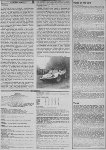
A2s remained the unanimous choice of the leaders while the uncertain played safe on M&S. It seems that Russell's most momentous mistake of the day was to change from A2 to M&S for the second and vital Hafren stage. It was here that he won the railly last year with some most determined driving while Airikkala struggled among the tattered shreds of his Avons. There was to be no such repeat this year and the decision, taken as a result of the morning's run and based on the probable effects on the surface of 180 competitors, proved to be unjustified. Russell dropped 17 seconds to Airikkala and despite a great effort in Myherin during which he shattered the 'record,' leaving it at 12.00m(!) he could only recoup 11 of those lost seconds, and finished 25s behind.
The extent of the Finnish Grand prix by mid. morning was a truly daunting spectacle. After two stages Russell lay in fourth place, 34 seconds behind the leader (Mikkola) and 23 seconds behind the eventual winner. Billy Coleman was fifth but had already retired having coasted to the finish of Hafren with a dead engine, the head of an inlet valve having broken off and in the resulting melee, destroyed cylinder head and piston in the new University Motors 12-valve engine which had sounded so excitingly crisp and harsh in Myherin. John Taylor was sixth, fighting a gradually losing battle against the understeer of his car which was eventually to catch him out on the very last stage. John had also to cope with poor brake bias initially so was still finding his true form.
Hafren itself was shrouded in low cloud as were many of the valleys and hillsides on that otherwise fine morning. The cold, damp mist swirled among the trees, blotting out the autumn sunshine and the bronze colours of the deciduous trees. It was a foreboding, almost opaque world that suddenly greeted crews after the crisp clear skies above Myherin. John Taylor had already had his first puncture a the end of SS1 but it was the critical one he receive just two miles into Dovey 2, after lunch in Machynlleth, which dropped him out of sixth place. Taylor however, struggled on sensibly until he came upon an acting and unofficial 'service crew' who helped him and Phil change the wheel in under two minutes! But the British were being soundly thrashed, and only Brookes was in a position to alter the balance of power. Andy Dawson was in the process of discovering that his car of the Lindisfarne had changed it character dramatically in the interim. He had been altering the front end geometry and brought in the camber by one third of a degree. Perhaps this move was a mistake, but more likely the real culprit was the crease in the bodyshell which first appeared on the Lindisfarne itself. The unpredictable results were no encouraging any real bravery, although Andy did change to A2s in the afternoon with beneficial effect to stage times if not to the driver's peace of mind.
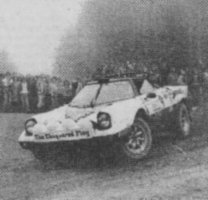
"The return of the Stratos was spectacular but brief."
Chris Sclater in DTV's second Chevette had a rally he would doubtless rather forget. He began by making a wrong choice of tyres (M&S); over-filling the car with petrol and sustaining a puncture in Pantperthog, but the problems began in earnest it Dovey 1 where the car eventually ground to a halt (after three miles) with a mysterious electrical failure. Having changed the ignition pack and received no sign of life from the hot engine, Chris set to work on the distributor, taking his own time (15 minutes) as there was noow no chance of avoiding a maximum. Working amid the intense heat from the motor, Chris changed the unit and re-timed the engine as best he could. The car obligingly restarted and allowed the crew the pleasure of a further Dovey where with a chronic misfire they struggled through, acquiring a puncture en route. Five miles from the end of Hafren 2 and after a service stop during which the engine was re-timed correctly, it spluttered to a halt once again. Without the necessary replacements now, the crew merely waited for rescue. However, one last try on the starter motor, after 20 minutes, when the engine had cooled, produced instant life, and Chris continued. He finished a most frustrating event by stopping to assist a stricken Jimmy McRae in Myherin's infamous ford, still mystified by the failure which apparently has no connection with DTV distributor failures in the past.
It's not often that Chris finishes 102nd overall on a rally, but then its not that often that Jim McRae finishes 24th either! He began the event knowing that nothing less than 10 points (a win in G1) would be enough to remain in contention for championship victory. He never managed to find his true form, and 1½ miles from the end of Myherin 1 a very sideways Magnum clipped a bank at a lefthand junction where the surface changes abruptly. The impact flipped the car over into the trees and with it went the time cards-out of the window. The crew had lost almost a minute, and a very fatiguing run of around four miles was required by David Brown in order to retrieve the lost time cards after they had reached the end of the stage. Following a depressing struggle through Hafren, a temporary screen was fitted and the Magnum soldiered on. All Jimmy could now hope for was that a tremendous performance from Gavin Waugh and Terry Kaby would keep Graham Elsmore's Thomas Motors RS2000 at bay. Gavin was driving an excellent rally, the fast flowing stages suiting the handling of the Avenger while tending to minimise its power disadvantage. While he found himself in the unaccustomed position of leading Group One, Terry Kaby, after a first stage without rear brakes following an oil seal failure, was finding the measure of the works Sprint and had in fact overhauled the Avenger and was extending a two second lead after Dovey 1 when he received a critical puncture on a front wheel, three miles from the end of the second Dovey stage. It lost the crew about 35 vital seconds and dropped them behind both Waugh and Goraham Elsmore who had to drive extremely hard to overhaul the determindly driven Chrysler. The Thomas Motors RS2000 was now being driven in a manner worthy of the new Group One champion and Graham finally took the lead after the Dovey complex to gain maximum points, and the championship after a very hard day's work from a quarter he had least expected it. It could so easily have gone either way, and all three drivers gave of their very best. Will Sparrow watched all this tumult from afar. It was not his day either, or in his own words "when the car wasn't being naughty, I was!" In Dovey 2 he spent three minutes off the road, having failed to negotiate a long left hand bend and been forced to take the escape road. In reversing back, the Avenger became stuck in the mud, and had to be towed out. Besides this incident, the engine spent most of the day misfiring badly, despite adjustments to the timing etc. While Will managed to struggle home fifth in G1, Malcolm Wilson had the distinction of drowning the County Garages car in the Myherin ford on both occasions! (losing him around a minute and half a minute respectively). In such close company, this was more than enough to keep him out of the three way battle at the toy.
The number of accidents and rolls were astonishing. It certainly was not a day for Magnums . . . to Jimmy McRae's efforts must be added those of Allan Arneil and Chris Lord, both of whom rolled in exactly the same place, Allan in the morning, Chris in was as slippery as ice, and Chris hung a back wheel over the edge which dragged El Gam over, rounding off most of the sharp edges and a day of mysterious electrical failures.
The Evans brothers also compounded a day of Vauxhall 'private owners' gloom by damaging the Vincent Greenhous car at the end of Hafren 2. Just before the flying finish, there is a very slippery square lefthand corner. Derek lost control of the car on the entry to the bend, and it rushed to the opposite side of the road before ramming a stout tree stump-a sad end to a day that had gone wrong almost from the start, when four miles into only the second stage they were confronted with Willie Rutherford's Mazda blocking the track. Willie had spun as a result of a puncture, and in trying to go round the car the Chevette was caught and dragged into a ditch where it remained for 40 minutes before being towed out by a tractor. . .
Three miles of the very last test of the day had been completed by John Taylor when the understeer with which he'd been fighting all day finally beat him and the car lunged head-first into the trees, where it stayed for seven minutes. After fighting back to sixth overall following the puncture in Dovey this was indeed a bitter blow, and one which severely dented his confidence, even, to the detriment of a night's sleep. The car however escaped unscathed despite refusing to answer its helm, and it will now probably be entirely rebuilt for the RAC. . .
Nigel Rockey is Castrol/Autosport champion; paul Faulkner struggled round to finish 14th and ensure himself of second place despite a broken clutch bearing and fork; Graham Elsmore is RAC Group One champion, and the odds are firmly in favour of another Finnish national champion. . . . Vauxhall must be as pleased as their highly talented driver.

